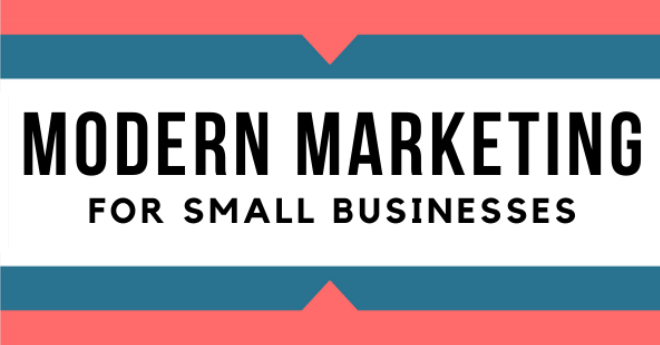4 Manual Marketing Tasks That Are Eating Up Your Time
Manual marketing tasks require a lot of your valuable time. We know it can be difficult to hand someone else the keys to some of the most critical...

Modern marketing uses technology innovations to reduce friction throughout the process of finding and retaining customers.
Contents:
The Foundation for Modern Marketing
Objectives of Modern Marketing
How to Implement Modern Marketing
Through our experience we have found the most challenging aspects for a business transitioning into modern marketing growth strategy are the perspectives of the people involved in implementing it. How willing a team is to recognize and remove their own internal obstacles is the key to success.
The dilemma you face in using modern marketing solutions is similar to what businesses faced as modern transportation methods became available for mainstream use. It was chaotic as people had options but no clear system in place to use them. It’s a helpful illustration for the dilemma facing your business today. Looking back on it from our modern point of view, it doesn't seem complicated. People just stopped using horses. Right?
The reality is there were decades of difficulties, especially for businesses. No roads were organized for car travel. Cities and towns were outlawing the use of automobiles because they created problems for existing infrastructure. This is similar to the ways companies sometimes restrict the use of internet channels for their employees or within their marketing efforts.
There were no parts stores on every corner which made it difficult to make repairs. These days, there isn't a clear set of standards for what platforms to use and how employees should interact with them. Back then, opinions varied about whether it was a waste of money to change delivery methods for goods and services. Should the stables full of horses and wagons be phased out? Should you be making changes to how your sales team engages with prospects and customers, using technology?
Just like now, the businesses of the past were being inundated with many new ways to do things and no clarity on how to use them. To navigate the rough waters of rapid innovation, you'll need to adopt ways to be nimble as you incorporate modern methods and manage constant change.
A lot of confusion surrounds the use of internet platforms. There are now thousands to choose from but you'll be relieved to know only a few are robust and efficient enough to be serious considerations.
There are common questions that surface for businesses who need to make changes to how they generate new leads. What platform should your website be built on? How do you incorporate content marketing with a blog and online lead generation? Where does social media fit into the picture? And what about SEO, the complicated methods to help people find your website? Why aren't you having the impact you expect from email marketing? Should your customer service team provide a live chat option? How can you identify the right solutions for your business?
This guide gives a rundown of everything you need to consider and is constantly evolving to help you make the right choices. It serves as a roadmap that will have your business meeting the expectations of your best prospects and customers. The first step is setting the right expectations.
Your perspective and mindset play a large role in how successful you are in implementing modern marketing and sales best practices. Many give up too soon because their expectations don't align with the strategy they put into place.
We often see businesses who are struggling with lingering remnants from pre-internet days. Times when options for promoting businesses were less diverse than they are today. Business marketing and sales strategy without the immediate influence offered by the internet operated primarily on a 30-day cycle and relied on print publications, television ads, radio spots and direct mail campaigns to promote offers. As time went on, email was incorporated into it but treated the same as the direct mail campaigns. The turn-around time between coming up with an idea for a new promotion, implementing it, and deciding whether it worked or not were short and not usually interdependent.
Businesses were in control of the sales process since prospects had to rely on them to get information. Training was focused on how to process transactions inside the businesses rather than on how salespeople would overcome the obstacles to meeting their sales goals. Sending salespeople out to contact large lists of prospects was viewed as enough to generate a steady stream of sales. The personal engagement, even when it was more rooted in tenacity than likeability, was a successful tactic. When goals weren’t met, volume of sales calls were labeled as the culprit.
Many businesses are likely to continue to follow the mindset of early-phase web-based marketing. Web pages and use of email and social media to reach people contain content that reads more like a steady stream of advertisements. The numerous channels available for digital marketing campaigns are used as avenues to get “free advertising." Online content can be plentiful or scarce for these businesses and it is situational and not working in tandem with other tactics. It has the short shelf life that resembles the offline advertising channels of the past.
For some, outdated methods are set in stone. By continuing to cling to techniques from the recent past, businesses can get their websites banned by search engines or be fined by regulatory authorities. Most of the time though, this mindset results in a lot of wasted time, money and effort.
Changing attitudes hasn’t only impacted how businesses reach out to their target audience, the sales process is also changing. Information is available to buyers from thousands of websites. The scale has tipped to favor them. Competition is fierce as the online “Rolodex” is crowded with new entries. It is increasingly difficult for businesses to grow, even with modern marketing tactics.
If your business is lagging behind in the ways described here, this guide is perfect for you.
Before you can successfully take advantage of modern marketing strategy, you’ll need foundational information about your business. Rushing straight to using the latest tactics and technology for marketing and sales requires the right foundation.
Answer the following questions in writing. This information will be used to successfully implement a modern marketing and sales system.
Using what you gather about your business from the previous step, you can set the objectives for your new business strategy.
Attract traffic to your website. The traffic to your website will be divided into the categories of site visitor, marketing qualified or sales qualified leads, and referral sources among others.
Connect with qualified leads. Put sales and marketing platforms in place that are designed to help you connect with site visitors who are qualified to buy from your company.
Once a site visitor goes from being a stranger to a sales qualified lead, you’ll need to have a system in place to keep track of where they are in the sales cycle and allow you to plan appropriate follow up. Your staff will need a collection of skills to use them. The process a buyer goes through from their first introduction to your company all the way through to becoming a customer usually doesn’t take place in a single encounter.
If your business can survive on the 30-day cycle of people showing up ready to be a customer with no cultivation from you, this guide isn’t for you. If you’re missing out by not giving attention to the middle stages that result in someone becoming your customer, putting in the time to learn and implement modern marketing and sales techniques will pay off!
How can you use technology to keep customers happy and get them to make referrals? Everyone wants the Holy Grail of word-of-mouth business growth. Today, it takes use of modern marketing and sales technology to cultivate it. In the same way you’ll be using internet-based tactics to get leads and close them into sales, you’ll use it to communicate with existing customers. In fact, your list of current customers will be the starting point for using web-based tactics to grow your business.
You will need to choose the right software platforms, provide staff with necessary training and use an assortment of tactics from a large pool of options. This is how you align your growth strategy to budget and other considerations unique to your business.
Just like in the example we used of early 19th century transportation changes, the choices you make here are greatly dependent on context. Where you fit on the spectrum within all of these rapidly evolving innovations will drive the collection of tactics that fit your needs. Is your business big or small? Do you have problems to resolve before you can fully implement any of the tactics? How will you manage these changes?
The next section covers the most common tactics used to implement modern marketing and sales strategy. Some may look familiar but take note of how they are being used today and consider how they fit your needs.
We've only scratched the surface of building the framework for modern marketing and sales that is nimble enough to evolve as technology changes. Sign up for our next webinar as we dive more deeply into the individual aspects of modern marketing. We cover a new topic each month and end each webinar by showing you how it fits the grand scheme of modern marketing and sales strategy and how to identify action items that are right for you.
Click the image below to download the complete eBook version of this article.

Manual marketing tasks require a lot of your valuable time. We know it can be difficult to hand someone else the keys to some of the most critical...

The ability to grow and scale your business requires developing a comprehensive marketing plan with clear and concise steps. It means boiling things...

Creating strong relationships with your audience both online and off is critical to a successful inbound marketing strategy.